


Charles
Sgonina and the worlds first Double knocker
engine.
–
reprinted from the
VMCC Magazine April and
May 1968
“Charles
Sgonina, Engineer,
Cardiff: - Sgonina, who is only 22 years old, has in the comparatively
short
time in which he has competed in speed events won over fifty awards. He
was
third in the French Grand Prix of 1921, and holds the Margam Cup for
fastest
time in a Welsh event. The sidecar record for Catsash Hill also stands
to his
credit. On the TT course, Sgonina has distinguished himself as an
intrepid but
calculating speedman. Present mounts: - Sgonina Special, AJS, and Verus”
So
reads a brief biography from the columns of a well-known motoring
Journal dated
March 1923.
Nowadays,
Charlie is continuing in the engineering trade in Cardiff.
My first encounter with him was
several years ago when I required a gear and exhaust cam to be made for
my
Clement Garrard engine.
Charlie
is a person who does not talk much about the twenties, when he rode in
many
International events, and it was a few years after my first encounter
with him
that he did chat on the Vintage era.
He
bought his first motorcycle in 1918, a belt driven 4hp Triumph. His
next machine was an Enfield,
which gave him his first taste of chain drive. Next a BRS Norton, belt
drive
and with a certificate that it had lapped Brooklands at 70 mph.
About
this time, Charlie decided to enter the world of Motorcycle
competitions, and
so he converted the engine of his Norton to OHV, using a steel cylinder
with
detachable ports.
He
raced the bike at the Weston Speed Trials and won a few events, then at
Pendine, then at Style Kop, B’ham. He was up against Graham Walker in
his last
race meeting, in the novice class, and managed to beat Graham. At this
meeting
Charlie and Graham Walker formed a long and lasting friendship. Even in
the
late forties, Charlie wrote several articles for Graham who was the
editor of
the “Green Un”.
However
the engine in the Norton had a short life, the piston cracked around
the
gudgeon pin, then Bang. Only the cam wheels being salvageable after
this
happening.
By
now the speed bug had really got a hold, so work was started so work
was
started on another engine. Norton’s were persuaded to part with one of
their
actual TT frames and gearboxes.
This
engine was not really as good as the previous one, but with many
alterations
did eventually get a move on. The bike performed in quite a number of
events
with moderate success.
As
Charlie once said: - “About this time I started to alter valve timings
and cam
design and found out what a lot of study must be put in on this
subject, as to
make a cam that looks good is silly. Anyone thinking of making new cams
must
first consider valve gear reciprocating weight, strength of valve
springs
permissible, and from this work out what kind of constant acceleration
cam
would be suitable. I always tried to fill the cylinder as full as
possible at
fairly high engine revs, and run on a compression ratio to suit the
hottest
plugs available, which meant that I was running on a lower compression
ratio
than many and getting more power.”
Anyway,
Charlie removed the engine from the Norton and put it into a frame that
he had
built.
The
next alteration was to put on an overhead
camshaft
driven by chain, which caused a considerable stir. Quite a number of
different
chain drives were tried, as the thrashing of the chain at certain
engine revs
was most disconcerting.
The
best type of chain drive was to drive to the mag and then on to the
camshaft
with a separate chain. Eventually a vertical bevel gear drive was
fitted, this
cleaned up the appearance but did not increase the speed.
There
were plenty of troubles with pistons and head joints, and on one
occasion the
con-rod broke just below the small end. On the other hand there was
little
trouble with the valves, using tungsten steel, heat-treated.
Although
Charlie ran on alcohol fuel in the TT and other events when riding for
Triumph,
he always used Petrol Benzole mixture for his own machines, which he
used for
pleasure as well as racing and always rode them to events under their
own
power, but was not always lucky enough to be able to ride them home.
Also, at
the time alcohol fuel was about 15/- a gallon and was difficult to
obtain.
Towards
the end of this engine’s life Charlie tried blowing it, but found that
this was
to be a disappointment and after having a few fires at speed the
project was
dropped. You can be assured that the flame coming from a blower will
beat any
brazing lamp.
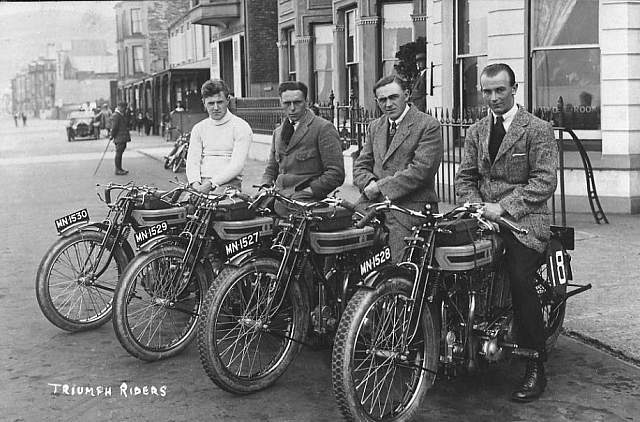 Next,
Charlie got fixed up with Triumphs to ride one
of
their new OHV 4 valve “Riccys” in the 1921 TT. Charlie is seen in the
white jumper with the rest of the Triumph factory works team in this
photograph. Left to right - Charlie Sgonina, Freddie Edmond, George
Shemans and Al
Pattinson.
Next,
Charlie got fixed up with Triumphs to ride one
of
their new OHV 4 valve “Riccys” in the 1921 TT. Charlie is seen in the
white jumper with the rest of the Triumph factory works team in this
photograph. Left to right - Charlie Sgonina, Freddie Edmond, George
Shemans and Al
Pattinson.
Charlie
went to the island full of hopes for the races but after his first
practice lap
realised that he would have to halve his time to be in the running.
One
lesson learnt during practice was never to let his eyes wander from the
road.
Seeing some friends waving to him he took his eyes off the road for a
fraction
of a second and found himself riding on the pavement. Quite
a shock, and he had his leg pulled, with one of the papers calling him
the
‘Pavement
Artist’. He was also described in the press as “a Welshman
with an
Italian
name, a sunny smile, and a mop of fair hair”.
Charlie
was third to start, riding behind Howard Davies on the little 2.75hp
Ay-Jay,
who was to be the winner of the event. Charlie reckoned that if he
could keep
Howard in sight then he would do all right. Despite the minute interval
between
starters you could see the chap in front out on the mountain
circuit.
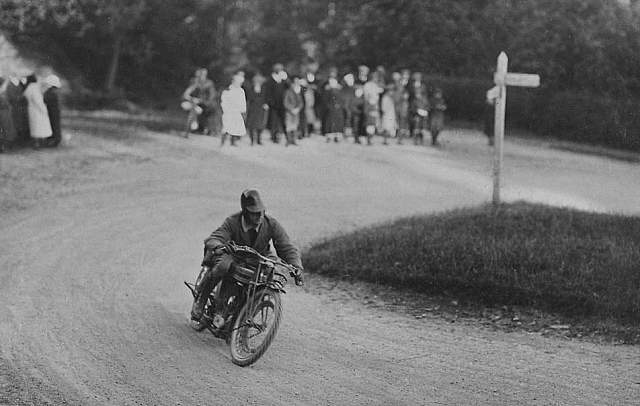 At
the end of the first lap, Charlie was lying
seventh on
corrected time. But the Riccy, which was performing well, decided to
drop a
valve, halfway through the next lap. The photo on the left was taken at
Ramsey hairpin - no tarmac in those days.
Freddie Edmond set up a
new lap record at 56.04mph, and finished 7th, whilst George
Shemans
brought one of the other Ricardos home in 16th Place. Al Pattinson, on
the fourth Riccy, retired
before the end of the race.
At
the end of the first lap, Charlie was lying
seventh on
corrected time. But the Riccy, which was performing well, decided to
drop a
valve, halfway through the next lap. The photo on the left was taken at
Ramsey hairpin - no tarmac in those days.
Freddie Edmond set up a
new lap record at 56.04mph, and finished 7th, whilst George
Shemans
brought one of the other Ricardos home in 16th Place. Al Pattinson, on
the fourth Riccy, retired
before the end of the race.
After
Charlie’s TT attempt he took the Triumph over to France for the French
Grand Prix,
in which he finished third in 3hrs. 24 mins., 58 secs., at an average
speed of
56.96 m.p.h. Unlike the TT you could practice at any old time and they
had
great fun going flat out through a bunch of chickens – but French
chickens know
how to look after themselves. One incident that Charlie recalls is
going round
with Freddie Edmond who was one of the Triumph team. They were riding
abreast
at 70 m.p.h. when they saw a cloud of dust ahead, about half way
through it
Charlie noticed a steam-roller, and wondering what had happened to
Freddie,
pulled up. Freddie also pulled up and said, “that was a close one, I
heard my
clutch lever go click against the back wheel of that steam-roller”.
The
race started and Charlie eased the Riccy on gently at first then went
practically flat out, stopping half way to fill up with petrol and oil.
He was
troubled by the Calcium Chloride that the organisers had put on the
road to
keep the dust down, which, when he swallowed gave him a sore throat.
However he
finished third and was able to gargle with champagne. His mechanic
stripped the
engine for measurement and as they had a huge case of champagne was
unable to
put it back together again.
Next
the Belgian Grand Prix, but after serious tyre trouble and that valve
again, the
Riccy was forced to retire.
Back
to Britain and the 500 miler at Brooklands. Charlie had not been on
the track
before; it
was quite an experience and great fun.
During
the race Fred Dixon burst a tyre right in front of Charlie’s mount
travelling
at about 80 m.p.h., he rolled over and over and lost a lot of clothing.
Charlie
remembers thinking at the time that Freddie would not be riding for
quite a
while. But he was tough and back in the race almost immediately.
Charlie
stayed on at Brooklands for a few days to try out the Triumph in
comfort but
dogged with trouble he had to leave the machine in the hands of Frank
Halford
to prepare before Charlie had a go at the Catsash Hill Climb. Frank
Halford
made a fine job of preparing the Riccy and at the hill climb Charlie
managed to
do some good. When Charlie returned the Triumph to Frank Halford he
promptly
broke the hour record at Brooklands with it.
At
Catsash Charlie knew that if it went well he could get both fastest
solo and
sidecar times. But unfortunately it turned out wet, the road being
muddy, so it
was decided to leave the sidecar gear ratio for the first run. George
Dance, on
the works Sunbeam, went up first, then came Charlie’s turn, with
terrific wheel
spin for some distance and on to the finish regretting that he had not
put on
the solo gear. He shut off on the line and started braking but was not
slowing
down quickly enough to pull up in the distance allowed and he knew that
he
couldn’t brake harder as his back wheel was locking. The T bend at the
end of
the straight, that might be taken at about 20 was close, and the bike
was still
travelling at 60. He decided to turn right and hoped to slide around
but
although Charlie put the bike over on to the inner footrest it just
slid
towards the hedge and bump, he was on top of the handlebars with his
legs under
him. George Dance was one of the first to help Charlie up and said that
he went
to the left and found it much softer. Charlie wasn’t feeling too good
and knew
that he was hurt internally. So, after a little rest, saw that the bike
was not
damaged and decided to ride only in the sidecar classes, all of which
he won
and put up the fastest sidecar time. Dance rode again in the solos and
went
straight through the hedge and was taken to hospital.
The
fastest Charlie ever travelled was at Pendine. In a one-mile sprint
race he was
up against Dance and his formidable Sunbeam. At the word “Go” Dance
gained
three feet and Charlie managed to gain on him at the rate of 2 foot 9
inches
per mile. In fact, when they stopped Dance said, “You just managed it”,
but was
contradicted by Charlie saying “You had it by three inches”. In talking
after
the event Dance said that he knew that his machine would do 95 any day
of the
week.
The
last engine that Charlie made was a 90-degree inclined O.H.V. with twin
camshafts with vertical bevel drive; a steel cylinder and a silicone
alloy die
cast piston. This was Charlie’s first attempt at die-casting and he
made at
least six before making a really good one. The pattern for the cylinder
head
was quite a difficult piece of work and some beautiful castings were
turned
out.
Charlie
was rather surprised at the strength of the valve springs required to
prevent
valve float, as the reciprocating weight was kept to a minimum as only
light
thimbles were used between the valves and cams.
This
engine was never fully developed, but seemed to have great
possibilities and
even in this state was better than any of Charlie’s previous efforts,
being
reliable and speedy and with slight alterations would have been ideal
to run on
alcohol fuel. It was road tested early one morning down Allensbank Road
in Cardiff
and reached 86 m.p.h.
Unfortunately
Charlie broke his arm when practising on a grass track.
What
with this,
the ban
being put on motor racing on public roads and the trade depression,
Charlie had
no encouragement to continue.
But
once the speed bug bites, you never seem to give it up, even in the
sixties
Charlie used to own and drive the Aston Martin that came third in the
Le Mans 24 hours in 1959,
and he handled it well on the “local” track at Llandow.
Charlie
used to own the 1914 TT Humber car owned subsequently by Kenneth Neve.
He used
to trailer it around the country towing with his 1913 Brescia Zust, so
there
are many more stories in the world of four wheelers to be told.
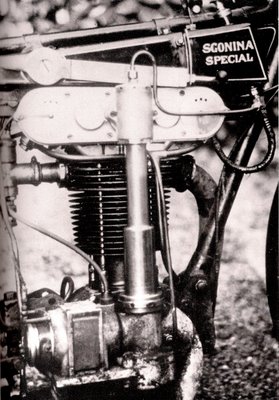
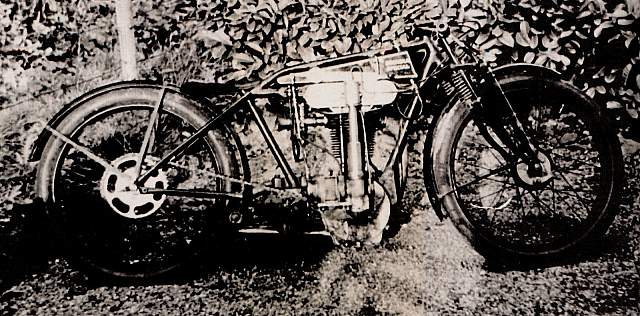
The Sgonina Special - mid 1920's
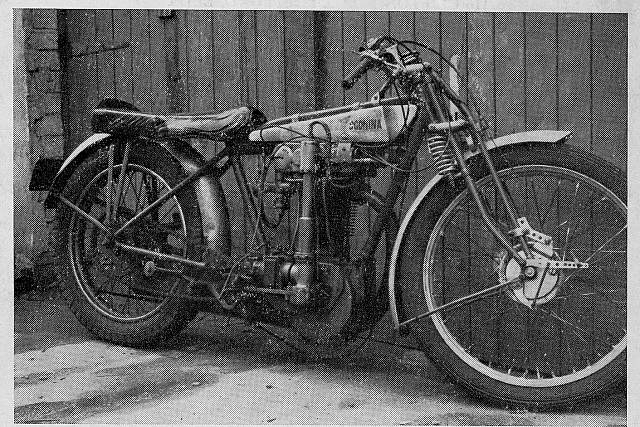
The
Sgonina Special when it was
owned by Felix Burke in Cheltenham – early
sixties – note that it’s fitted with wired on tyres.
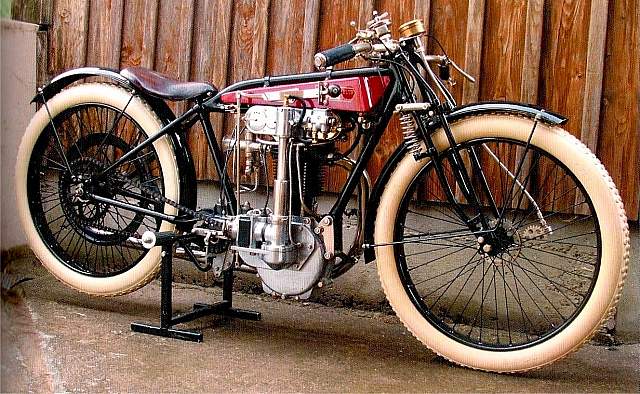
The bike today – fully
restored and in a museum
collection in bavaria,germany
BP






 Next,
Charlie got fixed up with Triumphs to ride one
of
their new OHV 4 valve “Riccys” in the 1921 TT. Charlie is seen in the
white jumper with the rest of the Triumph factory works team in this
photograph. Left to right - Charlie Sgonina, Freddie Edmond, George
Shemans and Al
Pattinson.
Next,
Charlie got fixed up with Triumphs to ride one
of
their new OHV 4 valve “Riccys” in the 1921 TT. Charlie is seen in the
white jumper with the rest of the Triumph factory works team in this
photograph. Left to right - Charlie Sgonina, Freddie Edmond, George
Shemans and Al
Pattinson.  At
the end of the first lap, Charlie was lying
seventh on
corrected time. But the Riccy, which was performing well, decided to
drop a
valve, halfway through the next lap. The photo on the left was taken at
Ramsey hairpin - no tarmac in those days.
Freddie Edmond set up a
new lap record at 56.04mph, and finished 7th, whilst George
Shemans
brought one of the other Ricardos home in 16th Place. Al Pattinson, on
the fourth Riccy, retired
before the end of the race.
At
the end of the first lap, Charlie was lying
seventh on
corrected time. But the Riccy, which was performing well, decided to
drop a
valve, halfway through the next lap. The photo on the left was taken at
Ramsey hairpin - no tarmac in those days.
Freddie Edmond set up a
new lap record at 56.04mph, and finished 7th, whilst George
Shemans
brought one of the other Ricardos home in 16th Place. Al Pattinson, on
the fourth Riccy, retired
before the end of the race.


